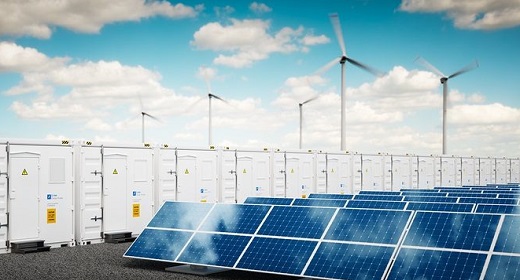by Seth Mullendore: This is what the early stages of an energy transformation look like…
How storage will power a low carbon energy transformation has begun to emerge across the country –surprisingly led by utilities in the Midwest and West as they pursue an economic mix of renewables and battery storage to shut down and replace existing fossil-fuel plants.
In just the past few months, in rather remarkable speed characteristic of disruptive change, utilities in California, Colorado, and Indiana have announced or advanced plans to replace more than 2.4 gigawatts of existing coal and gas with batteries and renewable energy, including two of the largest battery storage projects ever proposed.
California’s Peaker Replacement Plan
California has largely moved its electricity mix beyond coal, except for some imported electricity from outside the state, but still relies on natural gas for more than 40 percent of its in-state generation. Days are number for remaining gas plants as the state moves toward its newly enacted goal of achieving carbon-free electricity by 2045. According to recent report from Union of Concerned Scientists, Turning Down the Gas in California, a mix of renewables and batteries could enable in the retirement of more than half the natural gas plants operating on the California grid by 2030.
With approval in hand from the California Public Utilities Commission, the state’s largest utility, Pacific Gas & Electric (PG&E), is moving forward with four battery storage projects with the goal of replacing three existing gas plants, totaling 676 megawatts of gas generation. The gas plants are currently propped up by “reliability must-run” (RMR) payments authorized by the Federal Energy Regulatory Commission, which means these otherwise uneconomic plants are being kept alive and operating for grid reliability purposes.
PG&E’s storage projects are a big deal for a few reasons.
First, the four projects represent 567.5 megawatts / 2,270 megawatt-hours of storage, which is a lot of batteries.
Second, the systems include one project that will be the largest utility-owned battery installation in the world, a 182.5-megawatt / 730-megawatt-hour system from Tesla, and another that will be the largest third-party-owned installation in the world, a 300-megawatt / 1,200 megawatt-hour system being developed by Vistra Energy. Both are designed to be four-hour duration projects but the contract for the Tesla system includes the option of upsizing the batteries to six hours.
Third, if successful, these installations would be the first instance where battery storage has replaced existing natural gas plants in the country. There is no guarantee that development of these projects will result in closure of any, much less all, of the three gas plants, but PG&E aims to do so by calling on the systems to address reliability concerns that resulted in the RMR designations and payments for the otherwise uneconomic plants.
Development of the battery systems will not result in the immediate retirement of these plants but should chip away at their economic viability over time, causing them to run less and less and eventually cease operation entirely.
Forth, the projects could serve as a model for how these types of large storage systems could get financed and developed in other parts of the country. There is a huge market opportunity, with more than 1,000 peaker power plants in operation across the US, but it’s currently an unproven market opportunity for battery storage.
Coal Retirement in Colorado and Indiana
Coal is still king in Colorado and Indiana. Coal accounts for more than 50 percent of electricity generation in Colorado, and Indiana’s total coal consumption for electricity ranks second in the nation, after Texas. Based on recent proposals from major utilities in those states, how the dominance of coal will end, perhaps sooner than later, is now clearer.
In its 2018 Integrated Resource Plan, Indiana’s second largest utility, Northern Indiana Public Service Company (NIPSCO), reflected the some very low-cost bids it received for solar generation. The plan calls for the retirement of at least 1.35 gigawatts of coal generation by 2023 and another 400 megawatts by 2028. All that coal will be replaced by 1.5 gigawatts of solar and energy storage, along with 150 megawatts of wind and 125 megawatts of demand side management.
NIPSCO analyzed scenarios exploring the buildout of new natural gas plants or converting coal facilities to gas and found that development of renewables and storage offered the least-cost option for replacement of the coal generation. According to its analysis, the transition to storage-backed renewables will save customers $4.3 billion versus keeping the coal plants online through 2035.
Xcel Energy Colorado made headlines at the end of 2017 with the release of results from an all source solicitation that included astoundingly low bids for solar, wind, and battery storage projects. Based on those results, Xcel submitted a plan in June to boost wind, solar, and storage and phase out a third of its coal generation. That plan has now been approved by the Colorado Public Utilities Commission.
The plan calls for the retirement of 660 megawatts of coal generation and the addition of 1,100 megawatts of wind, 700 megawatts of solar, and 275 megawatts of battery storage. These will result in increasing renewables to 55 percent of Xcel’s Colorado generation mix by 2026. Xcel also estimated that the plan will save its customers more than $200 million.
Xcel Energy is now doubling down on it’s clean energy commitment, announcing a goal of achieving entirely carbon-free generation across its eight-state territory by 2050. It is the first major utility in the country to set such an ambitious target. Xcel executives believe it will be relatively easy to meet the company’s interim goal of 80 percent by 2030 with currently available technologies, noting that the incremental cost of renewables is already less than the embedded cost of running existing fossil-fuel plants.
Accelerating the Clean Energy Transition
Dropping costs of solar, wind, and battery storage have catalyzed the clean energy transition beyond its traditional borders. (Along with Colorado, Xcel Energy serves customers in Michigan, Minnesota, New Mexico, North Dakota, South Dakota, Texas, and Wisconsin.) Despite current political headwinds, coal plants continue to close and renewables are increasingly being adopted as the least-cost replacement option. Batteries are playing a pivotal role in this process by challenging gas as a necessary bridge to a cleaner grid.
What this all means for policies around energy storage and renewables also is now in sharper focus. The country’s ability to close down many coal plants and fight off new gas plants seems more in reach based on these recent actions.
Some academic papers have suggested that 80 percent of our existing fossil-fuel based energy systems could be replaced economically with existing renewables and storage technologies by 2050 (see Future cost-competitive electricity systems and their impact on US CO2 emissionsand Geophysical constraints on the reliability of solar and wind power in the United States). These recent utility and regulatory actions suggest such predictions are based on sound projections from already emerging renewables and storage economic and performance data.
It seems more possible than ever that the system can rely on existing clean energy technologies – a smart combination of increasing amounts of renewable energy and battery storage – to achieve a massive replacement of carbon-based fuels for electricity generation. If it is indeed possible to realize a grid powered by 80 percent clean energy generation, that would be a major success and a serious goal for the next few decades. Reaching beyond that goal to 100 percent might well require new, innovative longer duration storage solutions than today’s mainstream battery technologies.
These recent dramatic developments in the electricity sector may well put us on an achievable path to that 80 percent transformation milestone. That, in and of itself, is a hopeful sign for progress on climate amidst the recent onslaught of bad news that global climate emissions are once again on the rise.
















































